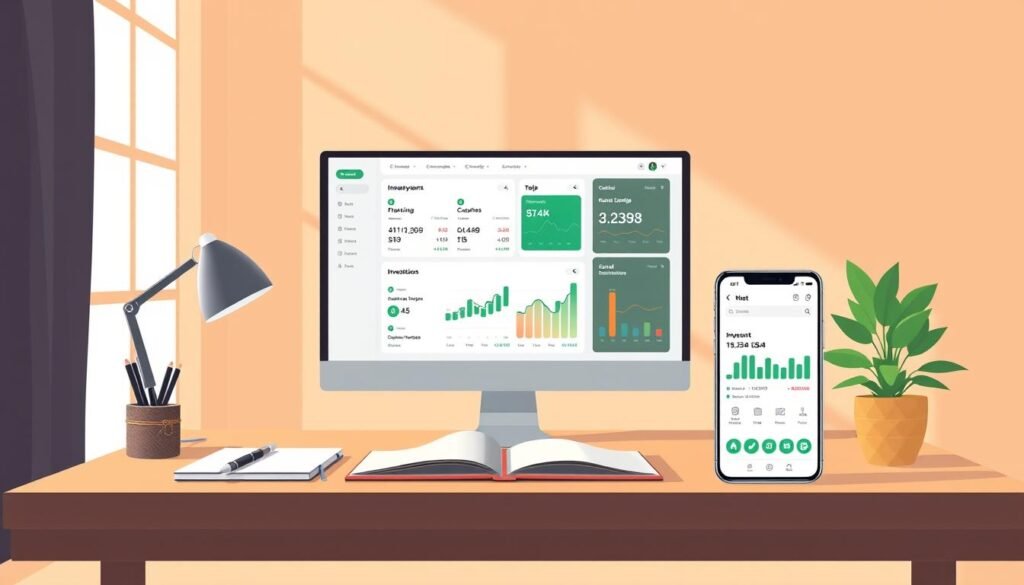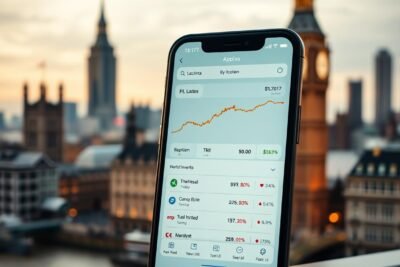
Start Investing for Beginners USA Step by Step Guide

Picture this: you open an account with just a few dollars. That night you sleep and the next morning your balance nudges up a little. It feels small, but it shows how an investment can make your money work while you rest.
New choices and terms can feel like a lot. The good news is there are only a few big decisions: set your goals, pick an account, decide how much to add, and choose simple investments.
This guide gives a clear path to start investing in the U.S. today. You’ll learn basic market ideas, how a simple portfolio may match your time horizon, and the trade-offs of risk and return.
Along the way you'll get practical tips on stocks, funds, order placement, and habits that help you invest money steadily. If you want a deeper roadmap, see a trusted resource at studyfinance.org.
- Why you invest now: benefits, risks, and what to expect in the U.S. market
- Set your goals before you pick investments
- Choose the right account for your goal
- Open and fund your account with confidence
- Pick your investment building blocks
- Ways to build your portfolio without the guesswork
- Place your first trade the smart way
- Manage taxes, fees, and expenses from day one
- Risk, diversification, and rebalancing for beginners
- Investing for beginners USA step by step: a sample plan you can copy
- Your next steps to start investing today
Why you invest now: benefits, risks, and what to expect in the U.S. market
Starting now means time can work in your favor, even with small amounts. Early action gives your money more chance to compound. That can improve the odds of hitting long-term goals like retirement.
All investment carries risk, including the possible loss of the money you put in. Diversification spreads exposure, but it won’t stop losses in a market-wide downturn. Bond funds, for example, face interest rate, credit, and inflation risk.
The U.S. market offers low-cost index funds, ETFs, active funds, and individual stocks. ETFs trade during the day and can differ from net asset value, while mutual funds trade once at day end.
Taxes and account rules shape your after-tax return. Tax-advantaged retirement accounts often improve outcomes versus taxable accounts. Pick an account that fits your goals, then match investments to your risk tolerance and time horizon.
- Small, regular contributions often beat occasional large wagers.
- Markets move in cycles; focus on long-term return potential.
- Use diversification and bonds to smooth swings, but keep expectations realistic.

Set your goals before you pick investments
Deciding what you want to achieve makes every later choice clearer. Name the goal, pick a rough timeline, and write a simple plan you can follow.

Retirement first: why many beginners start with long-term aims
Many people begin saving only after paying high-interest debt and building a small cash buffer. With retirement as a goal, you often use tax-advantaged accounts like a 401(k), 403(b), 457(b), or an IRA.
This approach lets time work on your side and usually supports a higher stock share in your investment mix.
Short-, mid-, and long-term timelines and how they guide your plan
Clarify your time frames: short (under 3 years), mid (3–10 years), long (10+ years). Each horizon affects how much risk you can accept.
- Write the amount you need and test a monthly contribution to meet it.
- Choose safer assets for short goals and more stock exposure for long ones.
- Sequence goals: secure retirement contributions first, then mid and short targets.
"Write down your goal in plain language so it guides choices during market ups and downs."
Use a simple example to test realism, then adjust time, contributions, or target. Keep the plan flexible and review it at least once a year.
Choose the right account for your goal
Which account you open matters as much as the investments you pick. Match an account to your goals and time horizon to control taxes and access to money. Rules, contribution limits, and company matches will shape your plan.

401(k), 403(b), 457(b): payroll, match, and tax rules
Workplace plans offer payroll deductions and tax-advantaged growth. Many employers match contributions up to a limit, so aim to capture the full match when you can.
Traditional options reduce taxable income today and defer taxes until withdrawal. Roth options use after-tax money and usually allow tax-free qualified withdrawals later.
Traditional and Roth IRAs
IRAs are useful if your workplace plan is limited or if you want extra retirement savings. Traditional IRAs may offer deductible contributions depending on income and plan coverage.
Roth IRAs use after-tax contributions and provide tax-free growth and withdrawals if you qualify.
Taxable brokerage accounts
Brokerage accounts give flexibility and access to stocks, bonds, mutual funds, and ETFs. There are no contribution limits, but you’ll owe taxes on realized gains, dividends, and interest each year.
Education accounts: 529 plans
529 plans grow tax-advantaged for qualified education expenses. State tax rules vary and nonqualified withdrawals may face federal tax plus a 10% penalty and possible state taxes.
- Tip: Let your goals and time guide which account to use.
- Check fees, available investments, and company plan menus before you commit.
- Know contribution limits, withdrawal penalties, and required minimum distributions.
Open and fund your account with confidence
A smooth account setup makes regular funding and good habits much easier. First, pick a provider whose services match how you want to manage money. Look for clear fees, easy apps, helpful education, and solid customer support.
Selecting a brokerage or provider
Choose a brokerage or plan that offers the tools you need. Many platforms have $0 minimums, fractional shares, and ready access to stocks and low-cost funds.
Check fee schedules and available investment options before you sign up. Good providers make transfers simple and show costs up front.
Funding options: lump sums, recurring transfers, and payroll deductions
Link your bank to enable one-time deposits or set up recurring transfers each month. Automatic transfers support dollar-cost averaging and reduce timing stress.
If you use a workplace 401(k), contributions go through payroll. Aim to contribute enough to capture any employer match that match is free return on your money.
How much to start and longer-term targets
Start with an amount that feels manageable and increase it over time. The habit of regular saving matters more than the initial size of your deposit.
- Aim toward saving 10%–15% of income over time, including employer match, for retirement.
- Decide whether a lump sum or monthly plan fits your budget; consistency wins.
- Confirm the account type before buying investments to avoid tax or penalty surprises.
Pick your investment building blocks
Pick simple building blocks that do the heavy lifting in your portfolio. Mutual funds and ETFs pool other people's money to hold many securities. That gives instant diversification with a single purchase and lowers the need to pick individual stocks or bonds right away.
Mutual funds vs ETFs: costs, trading, and target-date options
Mutual funds trade at the end of the day and can have minimum investments. ETFs trade intraday through a broker and may trade above or below net asset value.
- Use broad-market mutual funds and ETFs as core building blocks for your portfolio.
- Favor low expense ratios. Vanguard's average expense ratio was 0.07% versus the industry average of 0.44% (asset-weighted) as of Dec 31, 2024.
- Target-date funds offer an all-in-one option that adjusts stock and bond exposure as time moves toward retirement.
"Small differences in fees compound over time and can meaningfully impact long-term results."
| Feature | Mutual Fund | ETF |
|---|---|---|
| Price timing | End-of-day NAV | Intraday market price |
| Minimums | Often has initial minimums | Usually no minimums; can buy fractional shares on some platforms |
| Expenses | Expense ratios vary; check prospectus | Often lower expense ratios; trade commissions may apply on some brokers |
| Best use | Dollar-cost averaging, automatic purchases | Intraday trading, tax-efficient strategies |
Keep individual stocks as a small part of your account until you build a diversified fund core. Match the mix to your time horizon: more stock funds for long horizons, more bond funds for shorter goals. Always read a fund's prospectus to understand objectives, holdings, expenses, and risks before you buy.
Ways to build your portfolio without the guesswork
A simple framework beats guesswork when you assemble your investment mix. Pick one clear approach that matches your goals and time horizon. That keeps decisions steady when markets get noisy.
All-in-one funds and target-date options
All-in-one mutual fund or target-date funds give true one-and-done simplicity. These funds hold a built-in mix of stocks and bonds and rebalance as the target date nears.
They suit you if you want a hands-off core that needs little maintenance.
Robo advisors: automated portfolios, typical fees, and access
Robo advisors use low-cost etfs to build a diversified investment portfolio. Many charge about 0.25% of assets as management fees.
Services differ: some include tax-aware moves, automatic rebalancing, and access to a human advisor. Fees and eligibility vary and do not guarantee profit or protect from losses.
DIY with individual stocks and bonds
If you prefer a hands-on route, start with a low-cost core of index funds or etfs at your brokerage. Revisit your allocation once or twice a year.
Keep single securities as a small satellite sleeve to avoid concentration risk. Limit individual stocks and bonds so your diversified core stays intact.
- Decide your mix first (stocks vs. bonds), then pick low-cost funds that match it.
- Check provider services: rebalancing, tax tools, goal tracking, and access to advisors.
- Set up automatic contributions so your money keeps working while you focus on goals.
Place your first trade the smart way
Placing your first trade is easier than it looks when you follow a short checklist. Take a breath, confirm details, and use the tools your brokerage provides to avoid simple mistakes.
Ticker symbols, order types, and timing
Look up the ticker symbol for the stock, ETF, or mutual fund you want. Decide whether you will enter a market order (fast) or a limit order (price-controlled).
Market orders execute quickly but may fill at an unexpected price. Limit orders give price control but may not fill. Start small to confirm how your account shows trade confirmations and settlement.
ETFs at market price versus mutual fund end-of-day pricing
ETFs trade like stocks during the market day and can trade above or below their NAV. Watch bid-ask spreads and trade when liquidity is higher.
- Double-check the company or fund name and ticker before you submit.
- Keep some cash in the account to cover settlement and any unexpected fees.
- Review your brokerage fee schedule and use practice tools or help if you have questions.
"Don’t rush timing; align trades with your long-term plan, not headlines."
Manage taxes, fees, and expenses from day one
Small costs can quietly trim years off your long-term return if you ignore them. Start by knowing the fees your account charges and how they reduce your net gains each year.
Expense ratios, advisory fees, and trading costs to watch
Expense ratios are annual charges that lower your return. As a benchmark, Vanguard reported an average of 0.07% for mutual funds and ETFs versus an industry average of 0.44% (asset-weighted) as of Dec 31, 2024.
Advisory fees and trading commissions vary by provider. Also watch implicit trading costs like bid-ask spreads, which can add up when you trade ETFs or individual stocks and bonds often.
| Cost Type | Typical Impact | How to reduce it |
|---|---|---|
| Expense ratio | Annual drag on return (compounds) | Choose low-cost index funds or ETFs |
| Advisory fee | Ongoing percent of assets | Compare robo vs human advisor rates; use fee-only advisors |
| Trading costs | Commissions + bid-ask spread | Limit frequent trading; use limit orders and liquid ETFs |
| Tax inefficiency | Higher yearly tax bill in taxable accounts | Place less tax-efficient funds in retirement accounts |
Tax basics: dividends, interest, capital gains, and account-specific rules
In taxable accounts, dividends, interest, and realized capital gains usually trigger taxes each year. That reduces the cash you can reinvest unless you plan for it.
Retirement accounts (traditional) often defer taxes until withdrawal. Roth accounts can offer tax-free qualified withdrawals. Match asset location to tax rules: keep bond-heavy funds in tax-advantaged accounts when possible.
- Reinvesting dividends helps compound your money, but remember taxable income is reportable in taxable accounts.
- Review your provider’s fee schedule yearly small reductions in expenses boost long-term return.
- Manage cash intentionally: idle cash lowers growth, but keep reserves for near-term needs or rebalancing.
Keep clear records of contributions, distributions, and cost basis to make tax time easier. If you want tools to manage cash flow and budgets that support steady saving, see a helpful list of budgeting apps.
Risk, diversification, and rebalancing for beginners
Short-term price moves are normal what matters is how your plan handles them. Expect market ups and downs and avoid reacting to every headline. A calm approach helps you stay aligned with goals over time.
Diversification spreads exposure across asset classes and sectors, so one holding won't drive your whole outcome. Remember: diversification does not ensure a profit or protect against a loss.
Bonds can soften stock swings, but they carry interest rate, credit, and inflation risk. Use high-quality bond funds as stabilizers in your investment portfolio, and keep an eye on their role in your target mix.
Rebalance at least once a year to realign with your target allocation. Sell some winners and buy laggards to keep risk in check. Dollar-cost averaging investing equal amounts on a schedule helps you stay invested without timing the market.
- Choose a written target mix of stocks and bonds that matches your time horizon.
- Keeps your emergency fund separate so you don't sell during market stress.
- Review risk tolerance after major life events and adjust the portfolio as needed.
"Avoid performance chasing; stick with a diversified plan to capture long-term return drivers."
For further reading on how corporations and funds adjust allocation and manage risk, see this analysis on corporate adoption and allocation.
Investing for beginners USA step by step: a sample plan you can copy
A practical sample plan helps you move from idea to action. Use a clear target, a small monthly amount, and low-cost funds to keep things simple.
Example starter mix by time horizon and risk tolerance
Long-term retirement: 80% broad stock index funds and 20% high-quality bond funds.
Mid-term goals: about 60/40 stocks to bonds. Short-term: favor cash and short-duration bonds.
Use one or two mutual funds or etfs to create a clean investment portfolio that is easy to manage.
Month-by-month contribution plan with dollar-cost averaging
Translate your goal into a monthly amount and automate it on payday. Even $200 per month for 10 years at roughly 6% could grow to over $33,000, with about $9,000 in gains.
Set up automatic transfers, track fees, and rebalance once a year to keep your chosen mix on target.
When to consider a financial advisor and what services to expect
Many investors use an advisor when they face equity comp, multiple accounts, or tax planning needs. Robo-advisors often charge ~0.25% and use low-cost ETFs.
- Use a simple plan you will follow progress beats perfection.
- Consider an advisor for complex tax or estate needs.
- For extra reading on modern asset options, see this asset tokenization resource.
Your next steps to start investing today
Opening an account is often as simple as entering personal details, linking a bank, and funding a transfer. Many brokerages offer $0 minimums and fractional shares, so you can invest with a small amount and learn as you go.
Define your top goals, pick the best-fit account (401(k)/IRA for retirement or a brokerage for general goals), and set your first contribution. Choose one or two low-cost index funds or a target-date fund to start investing without extra complexity.
Automate monthly deposits, capture any employer 401(k) match, and aim toward 10%–15% of income over time. Compare platforms on fees, ease of use, and services such as auto-invest and access to an advisor. Skim tax rules for your account so you’re not surprised later.
Take action now: open the account, fund it, and place an initial investment. Small moves today improve your chance at a stronger financial future. Learn more trends like these two dividend stocks as you build confidence in the market.
If you want to know other articles similar to Start Investing for Beginners USA Step by Step Guide you can visit the category Investing.






Leave a Reply